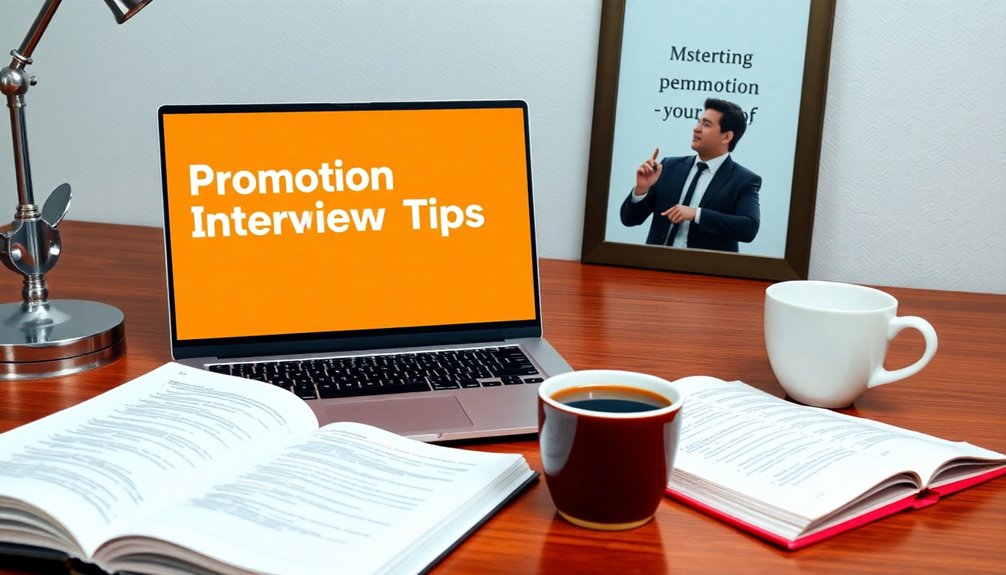Mastering promotion interviews means being well-prepared and strategically showcasing your achievements. Start by reflecting on your goals like salary and growth. Engage with colleagues to understand promotion standards, and discuss your ambitions with your manager for transparency. Create a strong case by compiling your accomplishments and aligning them with the job description. Practice common interview questions and prepare a focused action plan. During the interview, present your case confidently and listen to feedback. If you face rejection, respond professionally and seek constructive criticism. There's more to uncover about the nuances of this process to guarantee your success.
Key Takeaways
- Clearly articulate your personal expectations regarding salary, recognition, and growth during the promotion interview.
- Compile specific examples of accomplishments that demonstrate your readiness for the new role.
- Research the job description and align your skills with the responsibilities and company values.
- Prepare to answer common interview questions while showcasing your strengths and contributions.
- Engage actively with management, listen to feedback, and be open to development suggestions.
Preparing for Promotion Discussions

When gearing up for promotion discussions, it's vital to take a step back and reflect on what you truly want from the opportunity.
Consider your personal expectations, like salary, recognition, and growth. Engage with senior colleagues to gain insights into what's typically expected for promotions.
Be clear about whether you're seeking a salary increase or support in other forms. Think about your preferences: do you want more management responsibilities, or do you prefer focusing on individual contributions?
It's also important to discuss your intentions with your current manager for transparency and feedback.
Finally, research the new role thoroughly, including daily tasks and required skills, to guarantee your aspirations align with the company's mission and values. Additionally, understanding your company's leadership values can help you effectively communicate your alignment with their goals during the promotion discussion.
Building a Strong Case

To secure a promotion, you need to build a strong case that clearly demonstrates your qualifications and contributions. Start by researching the average salaries for the desired position to establish a factual basis for your request.
Review your current performance metrics and compare them against job expectations, identifying specific strengths. Compile examples of how you've exceeded your role's responsibilities, highlighting measurable achievements.
Create a portfolio showcasing these successes, as tangible evidence strengthens your argument. Clearly articulate your reasons for seeking the promotion, backed by data and metrics.
Finally, analyze the job description to illustrate how you've already taken on additional responsibilities, emphasizing your readiness for the new role. Additionally, consider establishing clear savings goals that can demonstrate your commitment to long-term planning, which may resonate with management's priorities. This thorough approach will make your case compelling.
Promotion Interview Preparation

Preparing for a promotion interview requires careful attention to detail and a proactive mindset. Start by reflecting on your accomplishments and how they align with the new role's responsibilities. Research the position thoroughly, noting required skills and daily tasks. Here's a quick table to help you organize your preparation:
| Focus Area | Action Steps |
|---|---|
| Personal Expectations | Identify salary, recognition, and growth |
| Research the Role | Review job description and company values |
| Accomplishments | Compile examples of past successes |
| Common Questions | Prepare answers for typical interview queries |
Engaging With Management

Engaging with management effectively is essential for a successful promotion discussion. Start by scheduling a dedicated meeting, signaling the importance of your conversation. Use a clear title, like "Growth Discussion," to set the tone.
Prepare for potential questions or concerns they might raise. Demonstrate your understanding of the company's goals and how you can contribute to them in your new role.
Be direct and confident in presenting your case, highlighting your accomplishments and readiness for increased responsibilities. Listen actively to their feedback, showing you're open to their insights.
Incorporating data-driven decision-making into your discussions can further illustrate your strategic thinking and alignment with the company's vision.
This approach not only showcases your commitment to growth but also builds a positive rapport with management, reinforcing your suitability for the promotion.
Handling Rejection Professionally

Receiving a rejection after a promotion discussion can be disheartening, but how you handle it can make a significant difference in your professional journey.
First, take a moment to process your feelings—it's natural to feel disappointed. Once you're ready, respond professionally. Thank your manager for the opportunity and express your commitment to growth.
Ask for specific feedback on your performance and what skills you can develop for future consideration. Setting SMART goals based on this feedback shows your dedication.
Keep the lines of communication open, demonstrating your willingness to learn.
Finally, focus on your current role—continue delivering high-quality work and supporting your team. This proactive approach not only enhances your skills but also positions you favorably for future opportunities.
Impact on Work Relationships

Although promotions can elevate your career, they can also shift dynamics within your team. You might find that your relationships with colleagues change as they adjust to your new role.
To navigate this, maintain open communication. Be transparent about your goals, and show your willingness to support your team. Acknowledge their contributions and foster an inclusive environment, as this will help build trust.
It's important to avoid any perception of favoritism; treat all team members fairly. Additionally, consider mentoring others to strengthen bonds and enhance collaboration. Establishing trust issues can hinder teamwork, so addressing concerns openly will promote a healthier work environment.
Setting Future Goals

How do you guarantee your future goals align with your new role after a promotion? Start by identifying specific, actionable objectives that not only reflect your aspirations but also meet the company's expectations.
Break down your goals into short-term and long-term targets, making sure they resonate with the responsibilities of your new position. Engage regularly with your team and management to assure alignment and gather feedback.
Focus on fostering team morale and encouraging collaboration, as these will enhance your leadership effectiveness. Finally, commit to continuous learning and development to adapt to evolving challenges. Additionally, prioritizing self-care practices can help maintain your well-being and performance in your new role.
Frequently Asked Questions
What Should I Wear to a Promotion Interview?
For your promotion interview, you'll want to dress professionally to reflect your seriousness about the opportunity.
Choose a tailored suit or a smart dress that aligns with your company's culture. Stick to neutral colors for a polished look, and make certain your clothes are clean and pressed.
Pay attention to your shoes; they should be formal and comfortable.
How Can I Manage Nerves Before the Interview?
Did you know that around 70% of people experience anxiety before interviews?
To manage your nerves, practice deep breathing exercises to calm your mind.
Visualize a successful interview to boost your confidence.
Prepare thoroughly by reviewing your accomplishments and the role's requirements.
Engage in mock interviews with a friend to simulate the experience.
Finally, remember, it's just a conversation about your future; focus on sharing your value and passion for the role.
Should I Bring a Copy of My Resume?
Yes, you should definitely bring a copy of your resume to the promotion interview.
It serves as a handy reference for both you and the interviewers. Your resume highlights your achievements and qualifications, reinforcing your case for promotion.
Plus, it shows you're prepared and professional. Even if they've it on file, having a copy on hand can help you discuss your experiences and contributions more effectively during the conversation.
How Long Should My Promotion Interview Last?
Your promotion interview should ideally last between 30 to 60 minutes.
This timeframe allows you to discuss your accomplishments, aspirations, and fit for the new role while giving your manager space to ask questions.
Keep your answers concise but thorough, ensuring you cover key points without rambling.
If conversations flow naturally, it's okay to extend a bit, but aim to respect everyone's time and maintain focus on the promotion discussion.
Can I Negotiate My Salary After Receiving a Promotion Offer?
Yes, you can negotiate your salary after receiving a promotion offer.
It's important to approach the conversation professionally and confidently. Start by researching industry standards and your company's compensation trends.
Clearly articulate your value, highlighting your achievements and the additional responsibilities you'll take on.
Be open to discussing other benefits too, like bonuses or extra vacation days, if salary flexibility is limited.
A respectful dialogue can lead to a favorable outcome for both parties.
Conclusion
As you gear up for your promotion interview, remember that preparation is your strongest ally. Like a well-tuned instrument, your confidence and clarity will resonate during the discussion, showcasing your readiness for new challenges. Embrace the insights you've gathered, articulate your achievements, and engage genuinely with your interviewers. Regardless of the outcome, each experience sharpens your skills and sets the stage for future success. Trust in your abilities, and let your passion shine through.
Eugene brings a fresh, dynamic voice to our platform as one of our talented Writers. Specializing in research-driven content, he explores the latest findings in psychology and personal growth, translating them into actionable insights for our readers. Eugene’s work is fueled by a curiosity about what makes us tick and a desire to help others unlock their potential.










